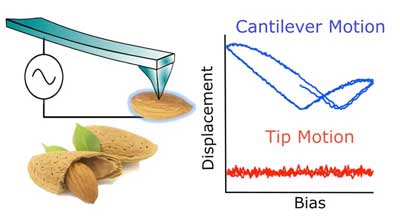| Dec 10, 2019 | |
Pushing the precision of nanoscale mapping(Nanowerk News) A popular microscopy tool can give false results about certain materials’ properties. For example, it has reported that almonds have electrical properties that they do not. The microscope’s physical motion creates background signals that cause these errors. |
|
| Scientists have developed a new quantitative approach to identifying and removing these artifacts (ACS Nano, "Quantitative Electromechanical Atomic Force Microscopy"). This new technique will provide a clear way to distinguish false motions from the sample’s true electromechanical phenomena in materials. | |
 |
|
| A breakthrough technique for overcoming instrument-based crosstalk in nanoscale measurements eliminates artifacts that lead to errors in biomaterials. (Image: Oak Ridge National Laboratory) | |
| There is a lot of potential for using microscopes to understand the relationship between motion and electrical processes in materials. This work could open routes to broad advances in energy storage, computing, biology, and medicine. | |
| A new technique focuses detection on the tip of the microscope, allowing scientists to directly measure the responses of samples. This approach could improve how well scientists can characterize materials at very small scales. Scientists currently use scanning probe microscopes to measure forces at nanometer length scales. | |
| However, larger physical and electrical forces can mask what is happening on the surface directly under the probe tip. These issues can result in instrument errors that this new technique will avoid. | |
| Voltage-modulated (VM) Atomic Force Microscopy (AFM) is the premier tool for locally probing phenomena on micro- and nanometer length scales. However, the commercial availability and wide popularity of VM-AFM has recently given rise to false reporting of new and unexpected functionality in materials. | |
| This is a problem that stems from known instrument-related interference. Like all scanning probe microscopes, AFM is susceptible to instrument “crosstalk,” or background signals that can mask the true atomic force measurement of interest and create misleading results. | |
| For the first time, researchers offer a new, easy-to-implement approach to overcoming crosstalk challenges in VM-AFM measurements. While traditional methods rely on optical detection to measure cantilever motions that are perpendicular to samples, the new approach combines a novel long-range calibration technique with recently developed interferometric detection to capture sample responses directly from the probe tip. | |
| The achievement greatly improves the ability to quantitatively distinguish sample measurements from background noise to create an accurate map of materials’ electromechanical functionalities. |
| Source: Center for Nanophase Materials Sciences, Oak Ridge National Laboratory | |
|
Subscribe to a free copy of one of our daily Nanowerk Newsletter Email Digests with a compilation of all of the day's news. |
